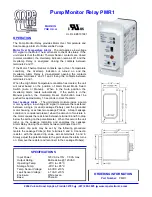
IG-150-EN version 04; 03/10/16
73
General instructions
ekor.rps
Protection functions. Description and settings
4.7.4. Directionality
In case the model has the “neutral directional” and the
“sensitive neutral” units, the later can also be directional,
for which it has the “torque control” setting (set to “YES”, it
indicates that it is directional, set to “NO”, it indicates that
it is not).
There are four types of directional for the sensitive neutral.
The angle (polarization by V
0
, it works as the neutral one),
the watimetric, the I•cos (
j
) and the I•sen (
j
)
The directional watrimetic and the cosine type directional
are almost the same, with the only difference that one is set
to W and the other one to A.
The corresponding settings are in “current protection (3)”
screen.
They work as a torque control of the sensitive neutral units.
These units are set in order to trip backwards or forwards.
Setting
Min.
Max.
Step
Directional type
Angular
I•cos(
j
)/I•sen(
j
)
watimétric
Minimum active
power (homopole)
0 – 100 W
0,01 W
For the watimetric directional
P = V
n
• I
ns
• cos(
j
-
j
c
)
j
= angle between V
n
and I
n
If the power is higher than this value in negative value it is considered as a forward
fault it is higher than this value in positive, it will be a backwards fault
Characteristic
angle φ
c
0 - 350°
1°
For all the sensitive neutral directional
Setting that allows taking into account the characteristics of the system that can be
used in lines with isolated neutral or with Petersen coil
Common setting with the cosine directional of
j
I
minimum
5 mA – 10 A
0,001 A
It is used for the directional I•cos(
j
) and the I•sen(
j
)
I
minimum
= I
ns
•cos(
j
-
j
c
)
j
= angle between V
n
and I
ns
If the minimum I is higher than this value in negative value, it is considered to be
forward fault If it is higher than this value in positive it is a backward fault
Table 4.12.
Directionality
Summary of Contents for ekor.rps
Page 143: ......
















































